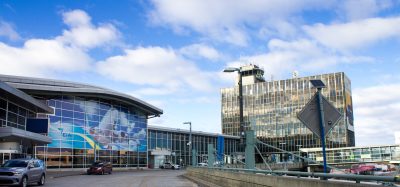70 years and no snow closure
- Like
- Digg
- Del
- Tumblr
- VKontakte
- Buffer
- Love This
- Odnoklassniki
- Meneame
- Blogger
- Amazon
- Yahoo Mail
- Gmail
- AOL
- Newsvine
- HackerNews
- Evernote
- MySpace
- Mail.ru
- Viadeo
- Line
- Comments
- Yummly
- SMS
- Viber
- Telegram
- Subscribe
- Skype
- Facebook Messenger
- Kakao
- LiveJournal
- Yammer
- Edgar
- Fintel
- Mix
- Instapaper
- Copy Link
Posted: 11 April 2011 | Craig Toomey, Canadian Freelance Business Writer | No comments yet
Montreal-Pierre Elliott Trudeau International Airport’s winter operations have kept the airport open regardless of weather conditions and become the envy of snowbound airports around the world.
The winter of 2010-2011 will go down as one of the toughest ever for airports in Europe and North America. Heavy snow, ice storms and freezing temperatures wreaked havoc on flight operations on both sides of the Atlantic. In some cases, they forced the complete shutdown of major airport hubs.
Montreal-Pierre Elliott Trudeau International Airport’s winter operations have kept the airport open regardless of weather conditions and become the envy of snowbound airports around the world.
The winter of 2010-2011 will go down as one of the toughest ever for airports in Europe and North America. Heavy snow, ice storms and freezing temperatures wreaked havoc on flight operations on both sides of the Atlantic. In some cases, they forced the complete shutdown of major airport hubs.
The disruption of travel plans for thousands of passengers led to widespread criticism that the airports were not properly prepared for the harsh weather conditions. This has put renewed pressure on airport authorities to revisit their snow removal procedures and winter contingency plans.
For several of the airport operators, these efforts include contacting Aéroports de Montreal (ADM), operator of Montreal-Trudeau and Montreal-Mirabel international airports in Canada and a recognised world-leader in snow removal.
ADM’s expertise in snow removal is much sought after because it has a remarkable track record for uninterrupted winter operations. “In our 70 years of operation, Montreal-Trudeau has never had to close because of snow,” affirms Normand Boivin, Vice-President, Airport Operations, ADM. “And keep in mind that we receive an average 220 centimetres of the white stuff a year, more than any other major airport in North America. In the winter of 2007-2008, almost 370 centimetres of snow fell on our city but we always kept the runways open.”
ADM has received several awards over the years for its snow-clearing expertise, including two Balchen/Post Awards for Excellence in the Performance of Airport Snow and Ice Control from the American Association of Airport Executives. The secret to its success, says Boivin, is a proven winter operations formula that combines best practices, advanced tools and experience. “You can have the best equipment in the world, but you need to know what to do with it,” he notes. “You need the right forecasting tools, the right procedures and the right instincts. We were born in the snow so have the experience that few others can claim in this field.”
Nearly 60 events a year
Montreal-Trudeau’s snow removal team, composed of about 40 permanent employees and 70 seasonal workers, is responsible for clearing more than 1.1 million m2 worth of apron, runways and taxiways – equivalent to driving 300 km. It tackles an average 57 snow events per winter. Together, these storms produce some 600,000 tonnes of snow that has to be hauled from the tarmac area each year in huge super trucks five times the size of normal dump trucks.
The team carries out this task with military precision, employing advanced technology tools, a modern fleet of snow removal equipment, and highly specific procedures to get the job done. “No two storms are alike so you really need to have systems in place that are both effective and flexible,” says Boivin.
The process begins with weather forecasting. “We start preparing as much as 24 hours before a forecasted event, but check again 12 hours prior since weather conditions can change rapidly,” says Boivin. “And because forecasts can be wrong, and storms under- or over-estimated, experience and instinct often play a role.”
Snow removal teams are called in depending on the severity of the anticipated weather event. ADM’s fine-tuned winter operations then go into action. These are controlled from a high-tech ‘snow desk’ that has a good vantage point for airfield operations and is equipped with sophisticated ‘Winter Ops’ software for call management and data handling.
“As soon as trace snow is found on the runways we dispatch the equipment,” explains Boivin. “And we take friction measurements as soon as a runway is cleaned because you cannot have any contaminated surfaces.” ADM uses the latest GPS and GIS systems to collect this friction, temperature and runway condition information in real time. The data is then sent to all stakeholders, including air navigation services provider NAV CANADA which provides it to airline pilots for takeoffs and landings.
Renewed fleet
Two years ago, ADM renewed most of the fleet of heavy equipment it uses for winter maintenance of the runways and aircraft manoeuvring areas at Montreal-Trudeau.
With twice the snow removal capacity of the old fleet, crews can now clear a 3,413m runway in 12 minutes. What’s more, the time it takes for an entire snow clearing operation has been pared to 25 minutes – 20 minutes faster than with the old fleet. “Combined with our new snow removal techniques, this equipment gives NAV CANADA more time to land aircraft, reduces the frequency of ground stops and saves aircraft fuel. So everyone is benefiting – the airport, airlines, passengers and the environment,” explains Boivin. “It took our staff some time to adapt to the new technology and operation of the vehicles but now they would never want to go back!”
The newly acquired machines include eight Oshkosh snow tractors, each equipped with a 7.32m wide plough in front and a 6.71m wide tow-behind broom. In comparison, the ploughbrooms on the old tractors were 4.27m wide. Also added were new snow blowers capable of blowing 5,000 tonnes of snow an hour, or nearly 50% more than the older machines.
In addition, Montreal-Trudeau purchased a new Tyler Ice liquid de-icer spreader capable of covering a 30.48m wide swath. The Tyler machine uses potassium acetate instead of urea, which had been found to deplete oxygen in runoff water, and boasts a tank capacity of 12,000 litres. It plays an especially important role in preparing airport surfaces before and during freezing or icy conditions.
This snow removal fleet is dispatched according to a clear set of priorities and based on the operational requirements of Montreal- Trudeau’s three main sectors of activity: domestic, transborder (Canada/US) and international flights. “The airport’s two main runways are cleaned on an alternating basis to ensure optimal fluidity,” notes Boivin. “And if the snowfall is very heavy, the cleaning is pretty much continuous.” Snow type (fluffy, wet, sticky, etc.) or freezing rain conditions are constantly monitored since these can affect the manoeuvres required and spreads employed, such as liquid potassium acetate (freezing rain) or granular sodium formate (snow).
Modern technology
ADM has also invested heavily in GIS/GPS technology to ensure safer and more efficient airfield operations. For example, in low visibility conditions, Aircraft Rescue and Firefighting (ARFF) vehicles and the Oshkosh snow fleet use a real-time GPS moving map display. This allows vehicle operators to see their respective location on the airfield and navigate to a known point (such as an aircraft) with audible and visual guidance. “GPS enhances the ability for vehicle operators to remain aware of their location and safely navigate during mission critical situations, such as aircraft retrieval,” explains Boivin.
ADM’s snow desk can also track the location of the entire snow fleet both in real-time and for historical purposes from specific desktop computer locations using Asset Tracking and Incursion Management (ATIM) technology. The same platform allows for the creation and set up of airfield geo zones, such as an area before a hold line. This can trigger an in-vehicle reminder to the vehicle operator that he/she is approaching a critical area on the airfield and can help to avoid hazardous incursions.
One of the biggest challenges Montreal- Trudeau faces is keeping areas around aircraft clean during a heavy snow storm while it is being serviced for departure or approaching a gate. “We have been adapting our equipment and using small sweepers and other devices to safely work around the aircraft,” says Boivin. By leveraging ATIM technology and maintaining constant communication with on-site team leaders, the snow desk can assign snow clearing and or chemical requirements to specific vehicles and then capture and record the progress in both real-time and for post event review.
ADM has also recently acquired an automated Radio Frequency Identification (RFID) system to count the number of dump truck loads and tally the volume of snow being hauled to its on-site dump. “Traditionally we used to post an employee at the snow dump to manually count the trucks entering and estimate the volume of snow they delivered,” explains Boivin. “But this took up significant manpower and led in some cases to an overreporting of snow deliveries by dump contractors.” Now, the RFID system is allowing ADM to accurately determine the volume of snow (approx. 4,000 m3 per hour) while saving manpower requirements, resulting in significant cost savings.
Unlike many airports in Europe and the United States, Montreal-Trudeau has been experiencing a relatively easy 2010-2011 winter in terms of snowfall, with 152 cm of snow and 39 events recorded as of mid-February. “We’ve had a lot of small snowfalls, which still require extensive intervention,” notes Boivin. “But overall operations have been running very smoothly. And with our renewed fleet, dedicated staff and seven decades of experience, we are confident we can handle almost any event that comes along for the next many years.”
De-icing operations a key element of Montreal-Trudeau’s success
De-icing airplanes is a vital procedure for airline safety in the winter and a critical component of Montreal-Trudeau Airport’s winter operations. It involves spraying a fluid, usually a heated glycol and water mixture, to remove frost, ice or snow from aircraft surfaces prior to takeoff. Crews in de-icing trucks with cranes on top spray the aircraft, usually in de-icing bays.
Montreal-Trudeau’s de-icing facility, opened in 1997, has five de-icing bays supported by 20 de-icing trucks capable of servicing up to 30 aircraft an hour. About 7,000 aircraft are de-iced every season. Nearly $40 million has been invested in the construction of a new centre that allows used de-icing fluids to be recovered via a system of underground pipes, thereby protecting nearby streams.
In addition, de-icing trucks are now equipped with state of the art technology, including sensors, to achieve more targeted delivery of de-icer and increase their effectiveness. This reduces the quantity of deicer used while ensuring compliance with the most stringent safety standards.
Since a certain proportion of de-icer can be recycled, ADM and its partners are currently working to implement a system to recover and recycle the product, and potentially re-use it in the de-icing process.
About the Author
Craig Toomey is a freelance writer who has been writing about the aerospace industry for more than 20 years. He is a former business reporter for the Montreal Gazette and also worked as a journalist for The Canadian Press. He is based in Montreal, Canada.
















